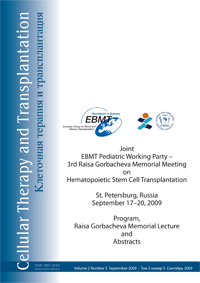Correlations between reactivation of herpesviruses and common complications of allo-HSCT
Olga S. Pankratova, Alexey B. Chukhlovin, Ludmila S. Zubarovskaya, Boris V. Afanasyev
Memorial R. M. Gorbacheva Institute of Children Hematology and Transplantation, St. Petersburg Pavlov State Medical University,
St. Petersburg, Russia
Summary
Patients and methods
We studied 145 patients with different hematological malignancies, including ALL (n=51), AML (n=37), CML (n=15), lymphomas (n=9), and MDS (n=6). They underwent allogeneic hematopoietic stem cell transplantation (allo-HSCT). The patients received bone marrow (35%), or peripheral blood stem cells (65%). Allo-HSCT from an unrelated donor occurred in 64% of cases. CMV-, HSV-, and EBV-specific DNA in leukocytes was detected weekly – with commercial PCR kits – up to 100 days after allo-HSCT. Cases of pneumonia, neurological signs, herpetic rushes, gut mucositis, hemorrhagic cystitis, and aGVHD grade were registered.
Results
HSV-, EBV-, and CMV-specific DNAs in post-HSCT blood samples revealed rates of 51%, 57%, and 45%, respectively (2.3 to 2.5-fold exceeding pretransplant rates). Types of underlying malignancy and gender did not influence these ratios. Following myeloablative versus reduced conditioning regimens, HSV positivity (>2 positive findings) was found in 36% and 21% of cases (p=0.02), respectively. Similar differences with CMV and EBV positivity were expressed only as tendencies.
Meanwhile, the incidence of HSV and CMV findings was age-dependent, i.e., minimal frequencies of PCR positivity were observed from 1–4 years of age, followed by increased viral reactivation from the age of 10–20 years. Among young patients (<21 years old), a correlation was found between neurological symptoms and multiple HSV positivity (p=0.002). Similarly, mucositis severity was associated with the persistence of either HSV, or CMV (p values, 0.02 and 0.008, respectively). Risk of intestinal aGVHD proved to correlate with EBV positivity (p=0.008). Similarly, a risk for posttransplant cystitis was dependent on EBV reactivation (p=0.01).
Conclusion
The study suggests that there is a correlation between repeated positivity of HSV, EBV, CMV, and some common complications after allo-HSCT. The significance of herpesvirus infection after allo-HSCT may be tested in further studies.
Keywords
hemopoietic cells, transplantation, complications, herpesviruses, reinfection


